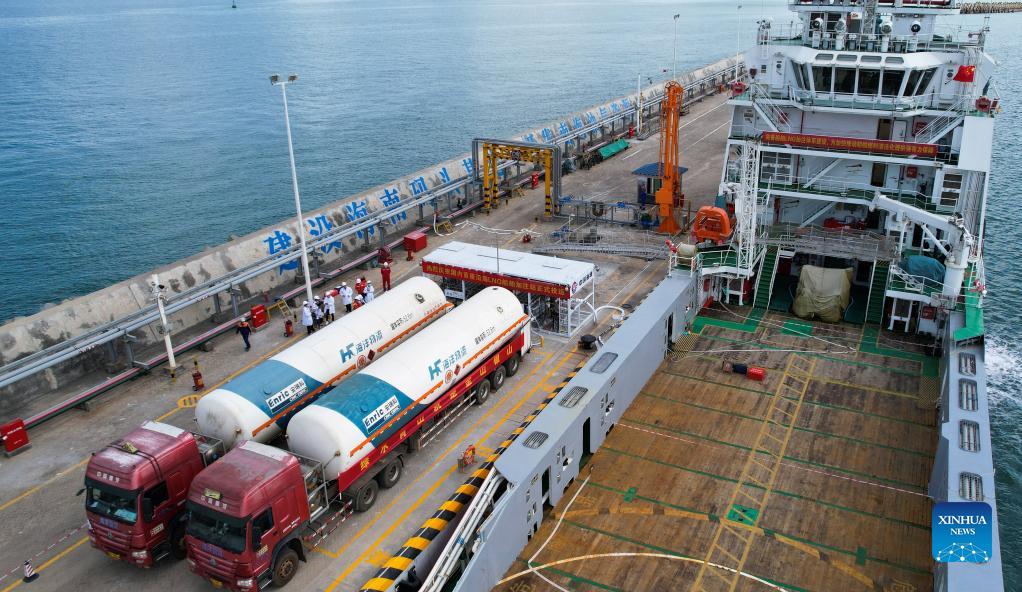
A berthed ship is being filled with liquefied natural gas (LNG) at an LNG filling station in Macun port of Chengmai County, south China's Hainan Province, November 20, 2021. /Xinhua
A berthed ship is being filled with liquefied natural gas (LNG) at an LNG filling station in Macun port of Chengmai County, south China's Hainan Province, November 20, 2021. /Xinhua
Editor's note: Azhar Azam works in a private organization as a market and business analyst and writes about geopolitical issues and regional conflicts. The article reflects the author's opinions and not necessarily those of CGTN.
Pandemic-driven lockdowns and travel restrictions in 2020 brought the world, including the American economy, to a standstill. Proved reserves of crude oil and natural gas in the U.S. dropped by 4 percent to 473.3 trillion cubic feet, according to the U.S. Energy Information Administration (EIA)'s year-end report released on January 13.
Liquid fuel production faced a critical shortage of available storage. Average annual price of liquefied natural gas (LNG) at Henry Hub, the natural gas pricing point traded on the New York Mercantile Exchange, also fell from $2.56 per million British thermal units (MMBtu) in 2019 to $2.03/MMBtu in 2020. Low gas prices forced many U.S. operators to cut their proved reserves estimates and phase down development plans for new wells.
Even before the COVID-19 entered our lexicon, demand for oil and gas was declining in part due to global economic slowdown over the China-U.S. trade war. The subsequent compelling circumstances in July 2020 progressively plunged the U.S. LNG exports to as low as 96,200 million cubic feet (mcf). Nevertheless, the country's exports bounced back in the last quarter of the year, setting new records in November and December with exports of 280,682 mcf and 304,263 mcf, respectively.
Other factors such as colder-than-normal winter temperatures in key Asian markets contributed to higher levels of exports. Yet deliveries of 125,723 mcf to Beijing, EIA data showed, in Q4 2020 too played an important role in reinstating Washington's LNG exports. China had burst into view with a flurry of purchases to evolve into the third-largest buyer of U.S. LNG by vessel behind South Korea and Japan.

Gas prices are displayed at a gas station in New York City, October 13, 2021. /Xinhua
Gas prices are displayed at a gas station in New York City, October 13, 2021. /Xinhua
Not only did the annual U.S. LNG export volume to China soared more than 31 times, annual increase in exports to Beijing accounted for over 36 percent of the total yearly surge. The trend continued and the U.S. LNG exports grew by 42 percent, or 2.8 billion cubic feet per day (bcf/d), to a median value of 9.6 bcf/d in the first six months of 2021 in the wake of greater global demand and rising LNG spot prices in Asia and Europe as well as about 200 bcf exports to China during the same period.
The U.S. LNG export capacity has widened substantially since February 2016, making the country third-largest LNG exporter in 2019 behind Australia and Qatar. It will be the world's largest once new LNG liquefaction units, called trains, at Sabine Pass and Calcasieu Pass in Louisiana are put in service by the end of 2022. At the close of this year, Washington's nominal and peak LNG production capacity would likely beat Canberra and Doha.
But to reach and maintain the milestone and capitalize on the full potential of its LNG sector, the U.S. still needs China, which dethroned Japan from decades-old title to become the world's biggest buyer of super-chilled fuel. Experts were prognosticating this to happen as Beijing blazed a trail by adopting and promoting several EIP (eco-industrial parks) standards and counted on a strong economic rebound to turn the tide on pollution and CO2 emissions. The EIA acknowledged Beijing's import and production growth was driven by government policies to switch from coal to natural gas in a bid to reduce air contamination and meet emission targets.
China had already surpassed Japan to emerge as world's largest natural gas importer in 2018 with combined imports by pipeline and LNG averaging 11.9 bcf/d compared with Tokyo's 10.9 bcf/d imports. Citing data from the International Group of Liquefied Natural Gas Importers, EIA said China LNG import capacity more than doubled from 5.8 bcf/d to 11.7 bcf/d between 2013 and 2020. By 2024, Beijing's LNG import capacity is estimated to expand by 4 bcf/d.
While the U.S. may not retain the crown of LNG export by capacity after 2025 when Qatar's North Field expansion would unseat it to regain the lead, American operators should develop new LNG plants to reinforce their leadership and take advantage from surging Chinese LNG demands. It is vitally important given China was the largest buyer of the U.S. LNG in the first 11 months of 2021, per EIA export statistics.
Last year, Chinese firms reportedly signed up contracts of more than 10 million tonnes a year of LNG with the U.S. exporters Cheniere Energy and Venture Global including two 20-year deals for an aggregate 4 million tonnes of LNG per year. They, Reuters said, will also double the volume of Chinese imports from the United States. As analysts forecast spot trade in LNG is set to witness over twofold increase of 2020 value to $20 billion by 2027, Beijing's trade liberalization offers an opportunity for Washington to deepen energy cooperation and expand its share in the world's biggest LNG market.
China and the U.S. are the world's largest energy consumers and producers. The disputes and disagreements between the two major global powers should be handled diplomatically, preventing them from upending the crucial trade and economic relationship. It isn't in the interest of Americans to keep tariffs on or ban Chinese products such as solar panels. The White House needs to realize the importance of bilateral trade and ought to broaden the scope of LNG trade into other areas that will bring even more strategic benefits to the United States.
(If you want to contribute and have specific expertise, please contact us at opinions@cgtn.com.)

